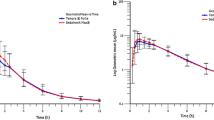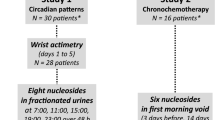Summary
The circadian variation of serum inorganic sulfate levels was studied in healthy volunteers. The effect of subchronic acetaminophen administration (650 mg q.i.d. for 4 days) on serum inorganic sulfate levels was investigated and the possible role of fluctuating serum inorganic sulfate levels on the pharmacokinetics of acetaminophen was evaluated.
During a 24 h cycle, serum inorganic sulfate levels were lowest in the morning (11.00 h) and typically increased in the afternoon to reach a maximum in the early evening (19.00 h). Average 24 h serum concentrations were 360 μM and the difference between minimum and maximum levels was on average 25.8%. Subchronic administration of acetaminophen (650 mg q.i.d. for 4 days) significantly reduced serum inorganic sulfate levels to a 24 h average of 253 μM. The circadian rhythm, however, was not affected and the difference between minimum (12.00 h) and maximum (18.50 h) serum concentrations was 31.3%. Subchronic acetaminophen administration lead to a significant decrease in the renal excretion (−51%) and renal clearance (−33%) of inorganic sulfate. No significant differences were found in the disposition kinetics of acetaminophen and its glucuronide and sulfate conjugates during two consecutive dosing intervals (08.00–14.00 h, 14.00–20.00 h) on Day 4 of the acetaminophen regimen.
Similar content being viewed by others
References
Becker EL, Heinemann AO, Igarashi K, Hodler JE, Gershberg H (1960) Renal mechanisms for the excretion of inorganic sulfate in man. J Clin Invest 39: 1909–1913
Berglund F, Sörbo B (1960) Turbidimetric analysis of inorganic sulfate in serum, plasma and urine. Scand J Clin Lab Invest 12: 147–153
Chaudhary A, Szakacs CBN, Herman RJ (1989) Lorazepam disposition in Gilbert's Syndrome: effect of feeding and fasting. Clin Pharmacol Ther 45: 166
Cocchetto DM, Levy G (1981) Absorption of orally administered sodium sulfate in humans. J Pharm Sci 70: 331–333
Cole DEC, Landry DA (1985) Determination of inorganic sulfate in human saliva and sweat by controlled-flow anion chromatography. Normal values in adult humans. J Chromatogr 337: 267–278
Cole DEC, Mohyuddin F, Scriver CR (1979) A micro-assay for analysis of serum sulphate. Anal Biochem 100: 339–342
Cole DEC, Scriver CR (1980) Age-dependent serum sulfate levels in children and adolescents. Clin Chem Acta 107: 135–139
Cole DEC, Scriver CR (1981) Microassay of inorganic sulfate in biological fluids by controlled flow anion chromatography. J Chromatogr 225: 359–367
Critchley JAJH, Clements JA, Prescott LF (1986) Concentration-dependent renal clearance of paracetamol sulphate and glucuronide in man. Br J Clin Pharmacol 21: 98P
Ferguson DB, Botchway CA (1980) Circadian variations in the flow rate and composition of whole saliva stimulated by mastication. Arch Oral Biol 24: 877–881
Greiling H, Schuler B (1963) Zur Wirkungsweise der Salizylsäure und des Salizylamids. Z Rheumaforsch 22: 47–56
Häkkinen IPT and Häkkinen LM (1959) Spectrophotometric determination of sulphate in serum and in urine with barium chloranilate. Scand J Clin Lab Invest 11: 294–297
Hendrix-Treacy S, Wallace SM, Hindmarsh KW, Wyant GM, Danilkewich A (1986) The effect of acetaminophen administration on its disposition and body stores of sulphate. Eur J Clin Pharmacol 30: 273–278
Herbai G (1970) A double isotope method for determination of the miscible inorganic sulfate pool of the mouse applied in in vivo studies of sulfate incorporation into costal cartilage. Acta Physiol Scand 80: 470–491
Houston JB (1982) Drug metabolite kinetics. Pharmacol Ther 15: 521–552
Kamali F, Fry GR, Bell GD (1987) Temporal variations in paracetamol absorption and metabolism in man. Xenobiotica 17: 635–642
Krijgsheld KR, Frankema H, Scholtens E, Zweens J, Mulder GJ (1979) Absorption, serum levels and urinary excretion of inorganic sulfate after oral administration of sodium sulfate in the conscious rat. Biochim Biophys Acta 586: 492–500
Krijgsheld KR, Scholtens E, Mulder GJ (1980) Serum concentration of inorganic sulfate in mammals: species differences and circadian rhythm. Biochem Pharmacol 67: 683–686
Krijgsheld KR, Scholtens E, Mulder GJ (1982) The dependence of the rate of sulfate conjugation on the plasma concentration of inorganic sulfate in the rat in vivo. Biochem Pharmacol 31: 3997–4000
Levy G (1986) Sulfate conjugation in drug metabolism: role of inorganic sulfate. Federation Proc 45: 2235–2240
Lin JH, Levy G (1981) Sulfate depletion after acetaminophen administration and replenishment by infusion of sodium sulfate or N-acetylcysteine in rats. Biochem Pharmacol 30: 2723–2725
Lin JH, Levy G (1983) Renal clearance of inorganic sulfate in rats: effect of acetaminophen-induced depletion of endogenous sulfate. J Pharm Sci 72: 213–217
Lundquist P, Martensson J, Sörbo, Öhman S (1980) Turbidimetry of inorganic sulfate, ester sulfate and total sulfur in urine. Clin Chem 26: 1178–1181
Malan J, Moncrieff J, Bosch E (1985) Chronopharmacokinetics of paracetamol in normal subjects. Br J Clin Pharmacol 19: 843–845
Meier MS. Schmidt-Kessen W (1978) Untersuchungen über den Stoffwechsel des anorganischen Sulfates. MMW 120: 357–362
Morris ME, Kwon O, Mansfield IL (1988) Sulfate homeostasis. I. Effects of salicylic acid and its metabolites on inorganic sulfate in rats. J Pharmacol Exp Ther 244: 945–949
Morris ME, Levy G (1983a) Absorption of sulfate from orally administered magnesium sulfate in man. J Toxicol Clin Toxicol 20: 107–114
Morris ME, Levy G (1983b) Serum concentration and renal excretion by normal adults of inorganic sulfate after acetaminophen, ascorbic acid, or sodium sulfate. Clin Pharmacol Ther 33: 529–536
Mulder GJ (1981) Sulfate availability in vivo. In: Mulder GJ (ed). Sulfation of drugs and related compounds. CRC Press, Boca Raton, FL, pp 31–52
Mulder GJ and Scholtens E (1978) The availability of inorganic sulphate in blood for sulphate conjugation of drugs in rat liver in vivo. [35S]-sulphate incorporation into harmol sulphate. Biochem J 172: 247–251
Reiter C, Müller S, Müller T (1987) Improved method for the determination of sulphate in human serum using ion chromatography. J Chromatogr 413: 251–256
Shively CA, Vesell ES (1975) Temporal variations in acetaminophen and phenacetin half-life in man. Clin Pharmacol Ther 18: 413–424
Tallgren LG (1980) Inorganic sulphates in relation to serum thyroxine level and in renal failure. Acta Med Scand [Suppl] 640: 1–100
Waschek JA, Fielding RM, Tozer TN, Effeney DJ, Pond SM (1986) Availability of plasma sulfate for conjugation of salicylamide in dogs. Biochem Pharmacol 35: 544–546
Author information
Authors and Affiliations
Rights and permissions
About this article
Cite this article
Hoffman, D.A., Wallace, S.M. & Verbeeck, R.K. Circadian rhythm of serum sulfate levels in man and acetaminophen pharmacokinetics. Eur J Clin Pharmacol 39, 143–148 (1990). https://doi.org/10.1007/BF00280048
Received:
Accepted:
Issue Date:
DOI: https://doi.org/10.1007/BF00280048




